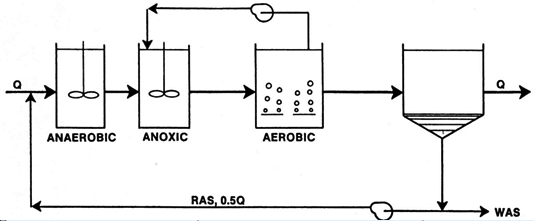- Influent composition & concentration
- Operating environment - pH, Temperature, D.O., MCRT, F/M, system design
While there is a great degree of variation in the species of microbes, we can classify many organisms based on their ecological niche in the biological treatment unit. Here are the most common functional groups.
- Heterotrophic Floc Formers – want microbes that uptake soluble organics. Best represented by the sponge analogy. Rapid uptake of organics with actual metabolism as the organisms pass through the system. Ideal organisms form biofilm/floc. This is composed of polysaccharides, proteins, DNA, adsorbed particulate organics, and other biological polymers. Want the “perfect” slime – that gives stable floc without holding too much water (viscous bulking). Manage populations with F/M or MCRT
- Keeping design F/M favors bacteria with rapid uptake of soluble BOD (organics)
- Stored organics in EPS used as “food” outside the abundant zone
- Too little EPS = pin floc or old sludge, too much EPS = non-filamentous or zoogleal bulking
- Niche Bacteria that require operator attention
- AOB/NOB – managed by adjusting MCRT & F/M – Alkalinity, D.O. Key concept is that both AOB & NOB are slow growing cultures so need lower F/M and longer MCRT.
- PAO – function in similar niche to Thauera/Zooglea. Rapid uptake of soluble organic acids for use as “food” later. To favor PAO over Thauera, have true anaerobic zone (no nitrate) with high organic acids.
- Denitrifying – very common pathway – nitrate/nitrite removal optimized by low D.O. (anoxic conditions) with soluble organics. Relatively high energy yield so these are common and can even thrive inside “aerobic” reactors.
- Sulfur Oxidizers/Sulfur Reducers - sulfur oxidizers have convert sulfides into sulfur and eventually sulfate. If you have sulfides in the influent, the SOX are important for AOB/NOB growth. The Sulfur Reducers (SRB) are found in anaerobic zones and generate sulfides - often found in collection systems & anaerobic digesters
- Filaments - Microbes that can grow into high surface area filamentous morphology. Filamentous bacteria in small quantities help floc formation by acting as a biological rebar to strengthen the floc. Once the filaments are bridging floc or extending free into the solution, you start to see filamentous bulking that can be a problem in secondary clarification.
- Foaming bacteria - this includes Nocardia and M. parvicella. Problem foaming is caused when influent contains insoluble organics (fatty acids or grease). These organisms use hydrophobic EPS to accumulate the fatty acids to support their growth. These are slower growing organisms than most heterotrophic wastewater bacteria, so they compensate for slow growth by exploiting their ability to grow on insoluble organics.



 RSS Feed
RSS Feed